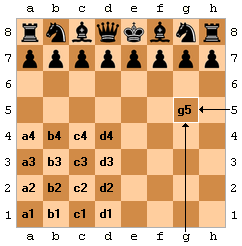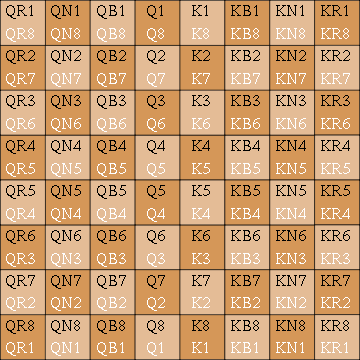|
|
Key Definition:
|
|
Ply-
|
|
One "half-move," i.e. what one player does when it is
her or his turn to move. This distinction is important because
the combinatorical explosion of positional possibilities in a
position is based on plies, not moves. Each ply represents another
multiplier of possibilities.
|
|
The basis of chess notation is not ply, but moves, and the moves are
numbered, from 1 to the entire amount of moves in the game. There are
times when a move for black is desirous of being discussed, and in this
case it can be designated by something like "34..Nxe4" which indicates,
that on the 34th move of the game, the player with the black pieces
noved a knight (designated "N" to not be confused with "king"--also
sometimes designated "Kt") and took the white piece (the "x" designates
"take the piece," but is actually not strictly necessary) that had stood on
the e4 square.
At right, is a diagram borrowed from the
wiki page
on this subject, showing how one determines the name of any square on
the board. It can be determined that at the start of the game, the
black king stands on the square e8, while his counterpart, if depicted,
would stand on e1. Castle kingside is designated "0-0," while castle
queenside is designated "0-0-0." If no piece name (either K, for king,
B, for bishop, N, for knight, R, for rook, or Q, for queen, which I will
note, are best capitalized) is given, then the move will designated
a pawn move, such as white's first move, 1.e4. Note that capitalization
of a piece name is important in the case of distinguishing a bishop
move from a move of the pawn that stands on the b "file." Note that
"files" are named by the letters, while "ranks" are named by the numbers.
When the moves of a game are given together, the black moves are
written immediately after white's, such as in the opening moves of
the Ruy Lopez game, i.e. 1.e4 e5 2Nf3 Nc6 3Bb5.
An important note would be that it is customary
to note the occurance of an en passant pawn capture should
be noted with "e.p." after a move to avoid confusion. A potential
example would be after possible moves in a French Defense Advance Variation,
i.e. 1.e4 e6 2.d4 d5 3.e5 f5 4.ef e.p. (the advanced e pawn can take
the f pawn that has advanced to f5, and is placed on f6).
Another important note is to discuss ambiguous moves, most often
occurring with either rooks or knights, but also once in a great
while one may promote to get a second queen, or even a second bishop
that stands on the same color square of another bishop. Although the late
GM George Koltanowski
made an amusing video discussing the possibility of gaining multiple
kings, it is not clear that this is in actual accordance with chess
rules. An example of avoiding ambiguity with piece moves, the possible
sequence is offered in the Open Sicilian Defense, after 1.e4 c5 2.Nf3 d6
3.d4 cd 4.Nxd4 Nf6 5Nc3 Nbd7, where black had the additional possibility
of moving the other knight, with 5..Nfd7. For more information on
this subject, again please consult the
algebraic wiki page.
|
|
|

|
|



